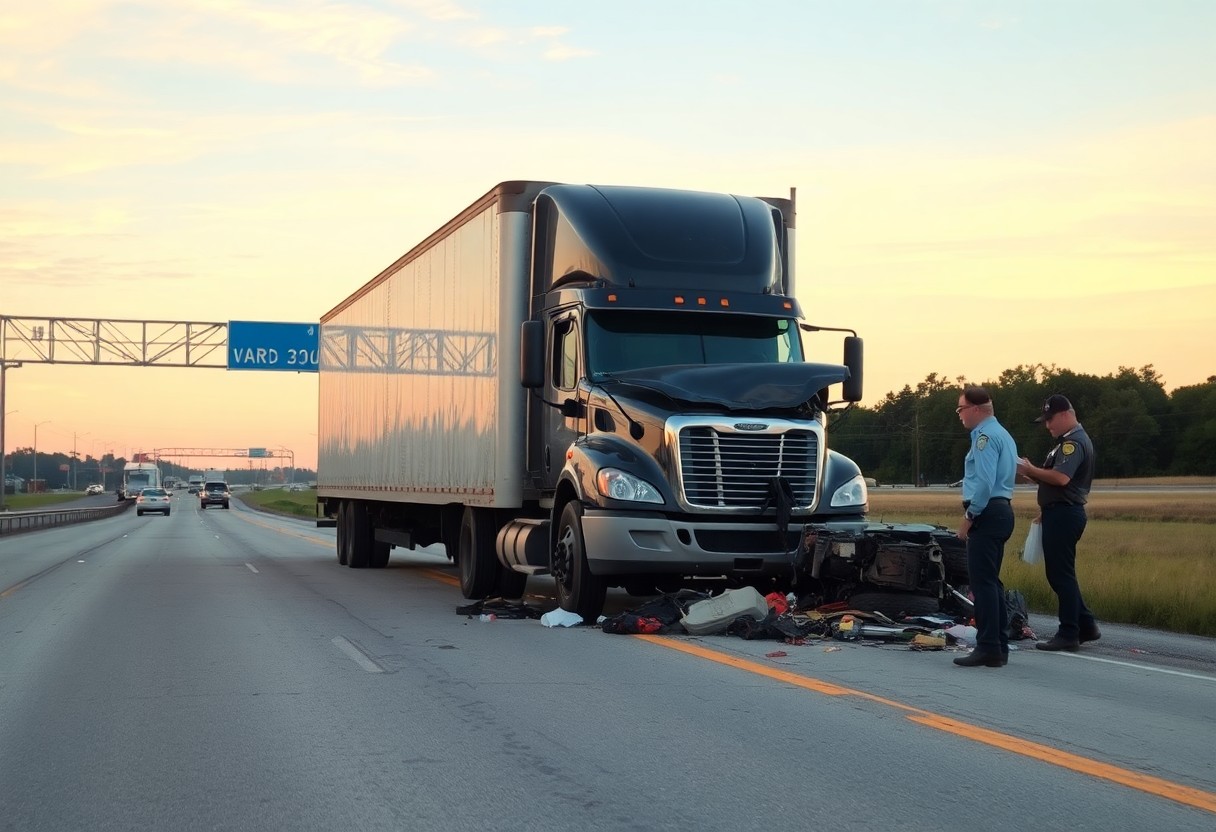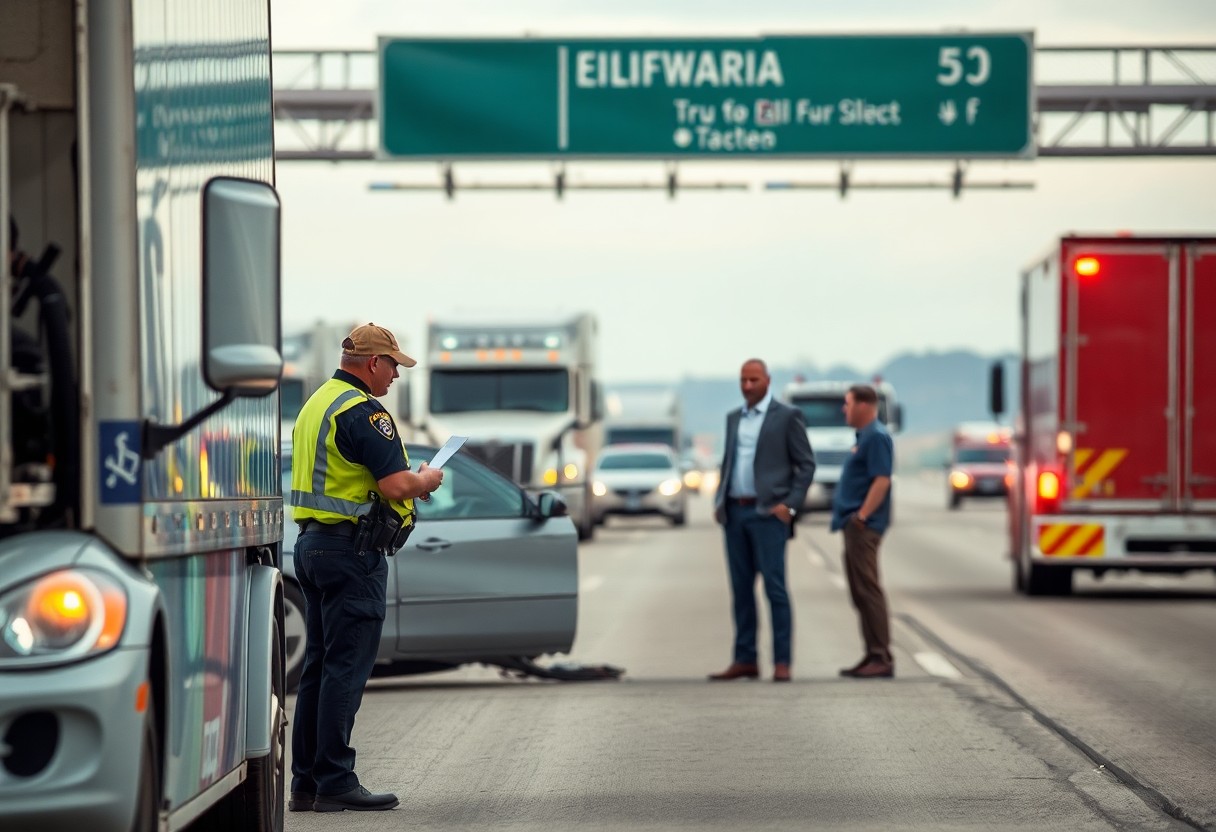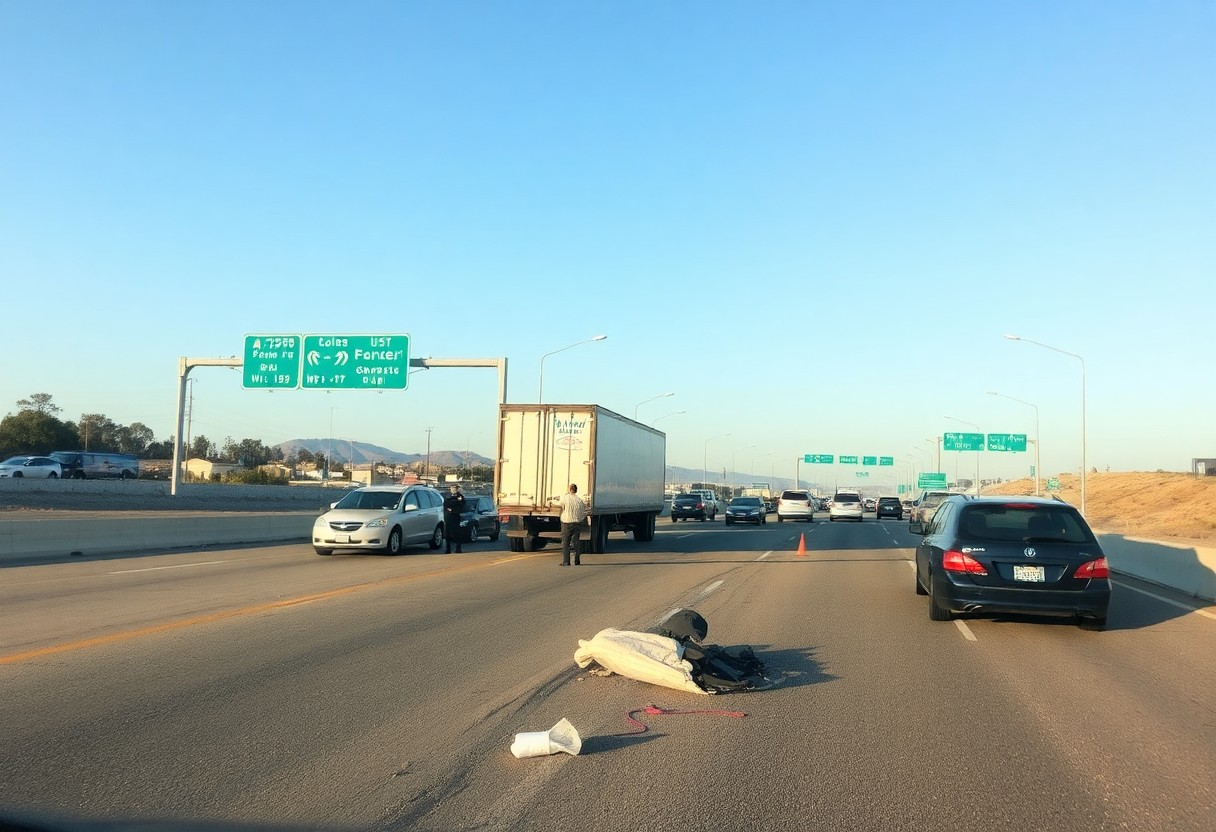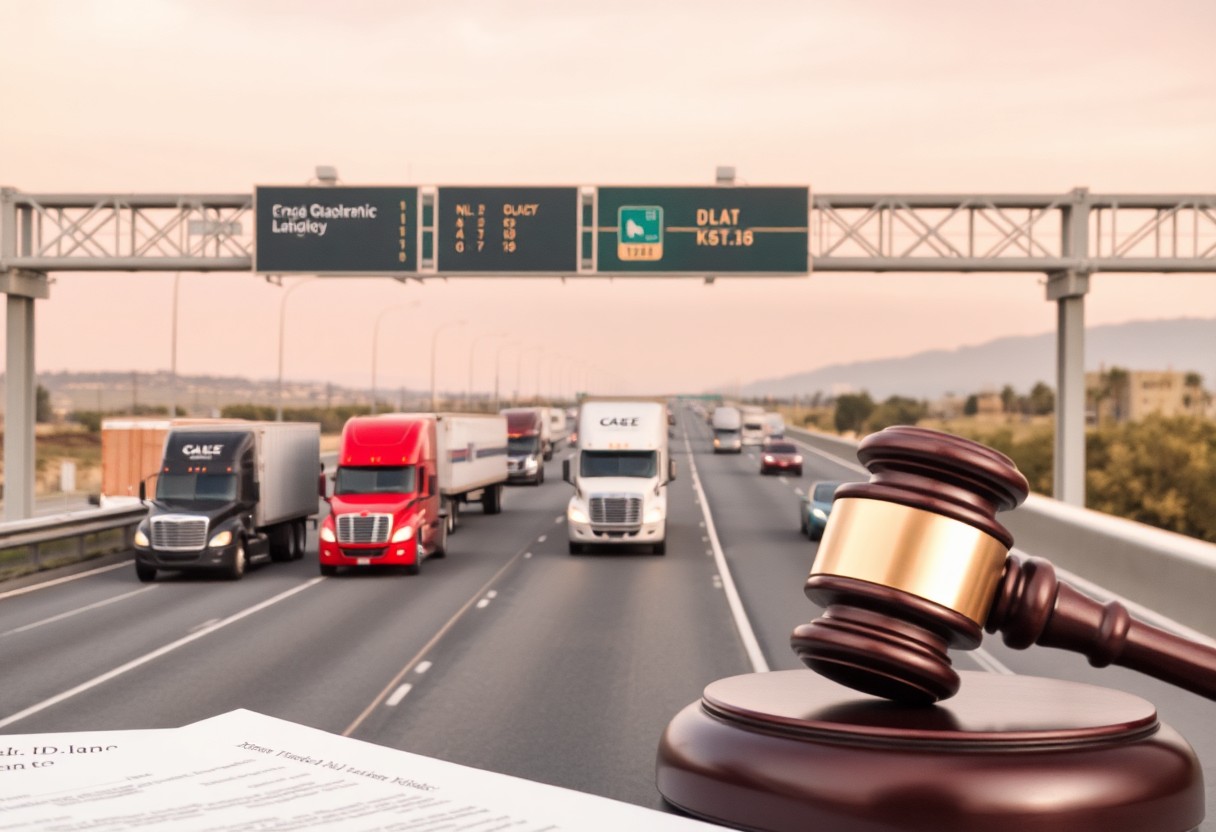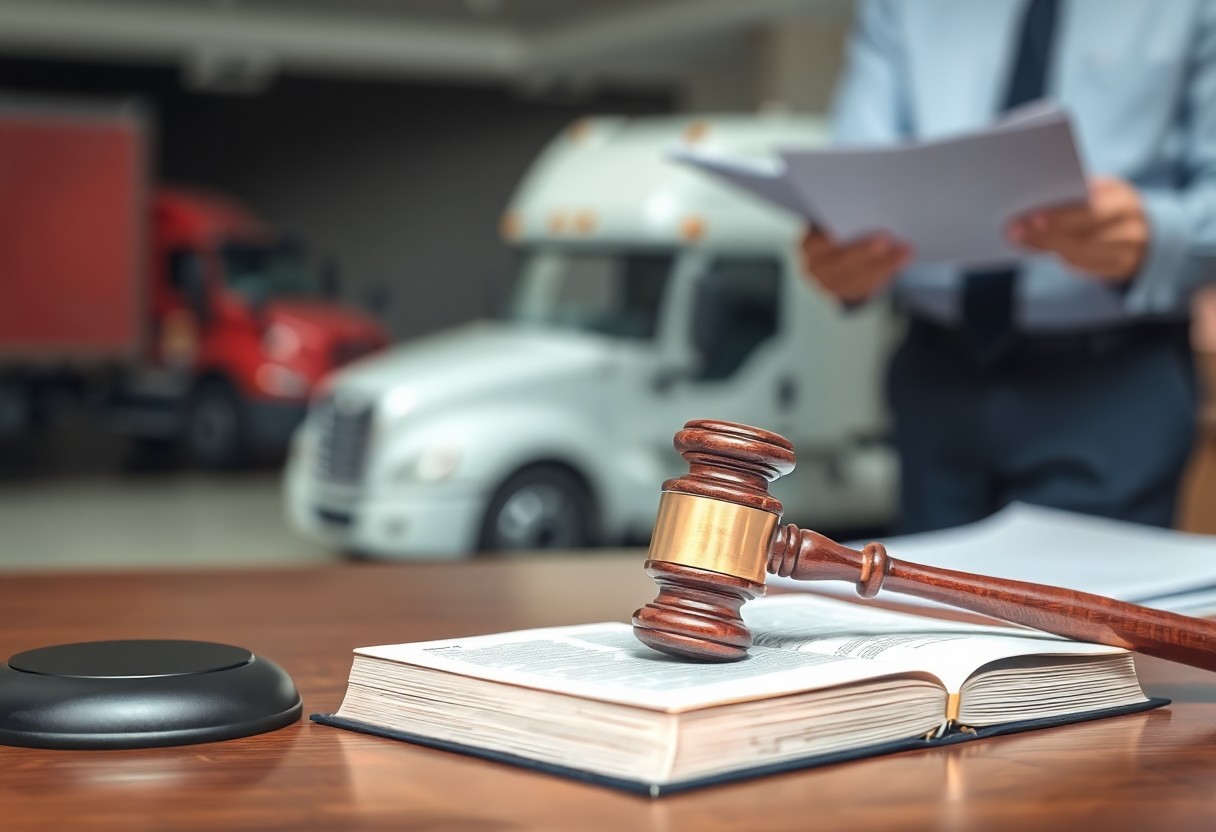Over the course of a truck accident in California, it is imperative that you gather imperative evidence to support your case. This evidence can significantly impact your ability to receive fair compensation for any damages incurred. Start by taking clear photographs of the scene, including vehicle positions and any visible damages. Additionally, collect witness statements and their contact information, as these can aid in establishing fault. Finally, be sure to document road conditions and any relevant signage to build a comprehensive account of the incident.
Physical Evidence at the Accident Scene
Your understanding of the physical evidence present at the scene of a truck accident can significantly impact the outcome of your claim. This evidence not only includes the condition of the vehicles involved but also any debris scattered around the accident site. The extent of vehicle damage can provide insights into the speed and angle of the collision, which can be pivotal in determining liability. Additionally, collecting information about debris, such as parts that may have come from either vehicle or cargo that has been lost during the accident, can be instrumental in painting a complete picture of the event.
Vehicle Damage and Debris
Any damage to the vehicles involved in the accident can serve as a powerful piece of evidence. Take photographs from multiple angles to thoroughly document the locations of dents, scratches, and any components that may have been damaged or displaced. This visual evidence will aid investigators in reconstructing the accident to better understand what transpired. Additionally, debris such as broken glass, pieces of metal, or personal belongings can play a key role in establishing the force of impact and the specific circumstances surrounding the incident.
Skid Marks and Road Conditions
Physical evidence like skid marks can reveal much about an accident’s dynamics and may indicate whether one or more drivers attempted to brake suddenly. These marks can show the speed at which vehicles were traveling before the impact and directionality, potentially indicating fault. It’s important to document the type of surface where the accident occurred, as factors such as wet or uneven roads can contribute to the events leading up to the collision. Take care to note any environmental conditions, like oil spills or potholes, that could have also played a role.
In addition, the weather at the time of the accident should be noted, as wet or icy conditions may have contributed to the drivers’ inability to stop in time. If there were any elements like fallen branches or roadside obstacles, this information is also valuable. Always meticulously record the road surface lapses, as these can significantly factor into liability decisions.
Traffic Control Devices and Signage
Before you leave the scene, take the time to capture the locations and conditions of any traffic control devices like traffic lights, stop signs, or road work signs. These devices may influence the actions of the drivers and provide insight into why the accident occurred. Always document whether these signals were functioning correctly or if they were obscured, damaged, or absent, as this can play a significant role in determining fault in the case.
Conditions affecting visibility, such as obstructions from shrubs or buildings, should also be noted. Signs that may have been ignored or obscured can become pivotal in proving negligence, so ensure you take detailed notes and photographs of all relevant signage near the accident scene. Proper documentation of these elements fortifies your position if legal action is required, enhancing your chances for a favorable outcome.
Documentation and Visual Evidence
If you find yourself involved in a truck accident in California, collecting thorough documentation and visual evidence is vital to your case. This information will not only support your claim but also provide a clear narrative of the incident, which can significantly influence the outcome of potential legal proceedings. It’s important to focus on gathering evidence that depicts the scene of the accident as accurately as possible, illustrating both the incident and its aftermath.
Photographs and Video Footage
Among the most useful evidence you can collect during and after a truck accident is photographs and video footage. Use your smartphone or any available camera to capture images that show the position of the vehicles involved, damage sustained, road conditions, and any relevant traffic signals or signs. It’s important to photograph any skid marks, debris, or other physical evidence that could provide insight into the cause of the accident. Additionally, if you can record video footage of the scene, especially if it includes witness reactions or immediate surroundings, it can serve as compelling evidence in your favor.
Police Reports and Accident Diagrams
On the day of the accident, a police report is typically drafted to document the incident. This report often includes the officer’s observations, details about the vehicles involved, and a preliminary assessment of fault. The police may create an accident diagram that illustrates how the collision occurred, which can be invaluable for establishing liability. Obtaining a copy of this report as soon as it becomes available can provide critical information that corroborates your version of events.
To effectively utilize the police report and any diagrams, review them carefully to ensure all details are accurate. If you notice any discrepancies or omissions, promptly address these with the police department, as they can affect the strength of your case. The report not only helps clarify what happened but also provides a formal record that may be referenced during legal proceedings.
Witness Statements and Contact Information
Before you leave the scene of the accident, it’s crucial to gather witness statements and their contact information. Witnesses can provide an independent perspective on what occurred, which can be crucial for your claim. Be sure to ask open-ended questions, allowing them to share what they saw. Additionally, collect their names, phone numbers, and addresses to follow up later if necessary.
Footage from eyewitnesses can offer a different angle of the incident that might corroborate your claims. Their accounts may include important details such as the truck’s speed, driving behavior, or any unusual circumstances leading up to the accident. A comprehensive collection of witness statements can greatly strengthen your case by providing further validation of your experience during the incident.
Commercial Truck-Specific Evidence
For anyone involved in a truck accident, collecting commercial truck-specific evidence is vital for establishing liability and understanding the circumstances surrounding the incident. This evidence includes documentation and data that only pertain to commercial trucks and their operations. Ensuring you gather these types of evidence can significantly impact the outcome of any legal or insurance claims that may arise from the accident.
Driver’s Logbook and Hours of Service Records
Logbook records are important in determining whether the truck driver complied with the federal Hours of Service regulations. These regulations dictate the maximum driving hours and mandatory rest periods to ensure that drivers are not operating vehicles while fatigued. If you can obtain the driver’s logbook, you’ll gain insight into whether the driver was operating within legal limits, which can be critical for establishing negligence.
Vehicle Maintenance Records
Above and beyond the driver’s log and hours, the vehicle maintenance records play a significant role in analyzing truck accidents. These records can reveal whether the truck was routinely inspected and adequately maintained, which is crucial for ensuring the vehicle was fit for the road. If you discover that the truck had outstanding maintenance issues or lacked necessary repairs, this evidence can support claims of negligence against the trucking company or driver.
Understanding the importance of these maintenance records helps you assess whether the accident was potentially preventable. If the records indicate mechanical failure due to insufficient maintenance, it can help establish a stronger case against the parties responsible for maintaining the vehicle.
Black Box Data and Electronic Logging Devices
Hours of operation are monitored through black box data and electronic logging devices (ELDs). These devices record vital information about the truck’s speed, braking patterns, and the precise moments leading up to the accident. If available, this data can provide valuable details about the driver’s behavior and the conditions during the accident, highlighting any potential reckless driving or violations of regulations.
This data is not only beneficial for understanding the moments leading up to the accident but can also help show if the driver was using the truck within the legal limits of operation. The black box can be your most authoritative source of information when determining liability and ensuring justice is served in the aftermath of a truck accident.
Environmental and Contextual Evidence
All truck accidents are influenced by their surrounding environmental and contextual factors, which can dictate the circumstances leading to the collision. Gathering this evidence is important for establishing liability and understanding the dynamics of the incident. Factors such as weather conditions, visibility, time of day, and the presence of any road work can provide valuable insights into how the accident occurred and what preventative measures could have been implemented.
Weather Conditions and Visibility
For instance, adverse weather conditions such as rain, fog, or snow can impair visibility and affect road traction. You should document any current weather reports at the time of the accident, along with taking note of any existing weather patterns like recent rains or snow that could have impacted road conditions. These factors are vital in determining whether the truck driver exercised reasonable caution given the environmental circumstances.
Time of Day and Lighting Conditions
Contextual factors such as the time of day and lighting conditions also play a significant role in truck accidents. For example, if the accident occurred at night or during dawn or dusk when visibility is reduced, it could indicate that the truck driver or other parties involved may not have adequately adapted to the lighting conditions. You should collect records from traffic cameras or nearby streetlights to assess how visibility might have played a part in your accident.
A thorough investigation into the time of day can further reveal whether fatigue or other human factors may have contributed to unsafe driving practices. Evaluating the lighting setup in the area—whether streetlights were functioning or if there were any obstructions blocking visibility—can enhance your understanding of the event’s circumstances.
Construction or Road Work Documentation
To fully understand the accident scene, you should document any construction or road work in progress at the time of the incident. This can include taking photographs of signs, barriers, or detours that may have disrupted the normal flow of traffic. Additionally, you should talk to workers or contractors present, as they may provide insights into how their operations could have affected the truck driver’s ability to navigate the area safely.
The presence of construction zones can introduce hazards such as narrowed lanes, unexpected stops, or improper signage, all of which can create dangerous driving conditions. Collecting this evidence not only helps in understanding how these factors contributed to the accident but also plays a vital role in asserting your claims for compensation if negligence is evident.
Medical and Emergency Response Evidence
Unlike some other accident scenes, gathering medical and emergency response evidence at a California truck accident can significantly impact your case. This type of evidence not only helps document the severity of injuries sustained but also provides insight into the response by medical professionals and first responders. It is imperative that you secure this information as it can be vital in establishing liability and understanding the extent of injuries involved.
Initial Medical Reports
About obtaining initial medical reports should be one of your top priorities after an accident. These documents outline the injuries assessed by medical personnel at the scene or shortly thereafter, helping to corroborate your claims. They often contain details such as diagnosis, treatment provided, and any immediate recommendations for further care, all of which provide vital context for your case.
Emergency Response Records
Emergency response records are a critical component of the evidence you will need. These records often include dispatch logs, incident reports, and any other documentation prepared by first responders who arrived at the scene. Such documentation can help illustrate the circumstances of the accident and how quickly and effectively emergency services responded. Any delays or issues noted in these records can be significant when discussing liability or seeking compensation.
In addition, these records may contain important details regarding the observations made by first responders, such as the condition of the accident scene, potential contributing factors, and eyewitness statements collected on site. These notes can be invaluable, showcasing the professional assessments made directly following the accident.
Injury Documentation
Across various aspects of your case, having comprehensive injury documentation is vital. This documentation includes all medical records, photographs of injuries, and any follow-up treatment notes. By compiling thorough accounts of your injuries, you establish a clear narrative that strengthens your claim and helps quantify your damages in terms of medical expenses and pain and suffering.
Reports regarding your injuries should detail the progression of your condition, treatment outcomes, and any ongoing issues stemming from the accident. Maintaining these records not only supports your case but also highlights the significant impact the accident has had on your daily life and wellbeing.
Insurance and Company Information
After a truck accident in California, collecting information regarding the trucking company and their insurance provider is necessary for your claim. This involves gathering details about the company that owns the truck involved in the accident. The trucking company’s name, address, and phone number should be documented accurately. Additionally, you should note the vehicle’s license plate number and any identification numbers visible on the truck, as these details help identify the specific fleet. Make sure to also inquire about any potential affiliation the company has with third-party logistics providers, as this may impact liability in your case.
Trucking Company Details
After securing the truck’s details, focus on collecting the relevant information about the trucking company. This can include what type of cargo the truck was carrying at the time of the accident, as certain cargo types might influence safety protocols and regulations. If possible, obtain the company’s DOT (Department of Transportation) number, which will give you access to their safety record and inspection history. This knowledge is critical, as it could play a role in determining the company’s overall safety practices and whether they adhered to them on the day of your accident.
Insurance Documentation
With the trucking company details collected, it’s time to gather relevant insurance documentation. You should request the insurance company’s name, policy number, and contact information. Knowing the coverage limits of the trucking company’s insurance is vital, as it may affect the compensation you can receive for damages. If the truck driver was working as a company employee, you may also want to verify whether they have personal liability insurance that could provide additional coverage for your claim.
Hence, it’s advisable to ask for copies of any insurance cards or documents that confirm the policy details. Documentation substantiating these insurance details will be beneficial in your communications with your insurance provider and legal counsel if you choose to pursue a claim. This information ensures that you have a clear understanding of the coverage available and helps in potentially negotiating a fair settlement.
Driver Credentials and Employment Records
Among the necessary information to gather, the driver’s credentials and employment records should also be prioritized. It is necessary to document the driver’s name, commercial driver’s license (CDL) number, and any endorsements they may hold. Also, it is important to find out how long they have been employed with the trucking company, as well as their driving history and past accidents. This information could indicate whether the driver had any prior issues that may be relevant to your case.
Also, consider collecting the driver’s training records or certifications, which can provide insight into their qualifications and adherence to safety protocols. If the driver has a history of unsafe driving or has failed to comply with required safety training, this might strengthen your case against the trucking company and their liability for the accident. Understanding these details will equip you with the necessary information to address any negligence involved in your truck accident claim.
Summing up
From above, it is clear that collecting necessary evidence at the scene of a California truck accident is vital for establishing responsibility and supporting your case. You should prioritize documenting the scene thoroughly by taking photographs of the vehicles, road conditions, and any visible damages. Additionally, collecting witness statements and contact information can provide further validation of the events leading up to the incident. Keeping a detailed record of everything that transpires will greatly assist you in the quest for fair compensation.
Moreover, it is important to obtain any available police reports and seek medical attention, even if you feel fine initially, as injuries may not be immediately apparent. The more comprehensive your evidence collection is, the stronger your position will be should you need to negotiate with insurance companies or pursue legal action. Taking these steps not only helps protect your interests, but also facilitates a better understanding of the accident’s circumstances, ensuring you have what you need to move forward effectively.



